Globalization, Trade Blocs, and Croatia's Economic Development
VerifiedAdded on 2020/06/05
|19
|4315
|35
Report
AI Summary
This economics report examines the transformation of the Croatian economy, focusing on the impact of globalization and trade. It analyzes Croatia's integration into trading blocs like the European Union, World Trade Organization, and European Free Trade Agreement, and the effects of these memberships on GDP, inflation, and employment. The report explores trade creation and diversion within these blocs, as well as the advantages and disadvantages of Croatia's transition to an open market economy. It further investigates the effects of globalization on Croatia's trade relations, including the gravity model and the Ricardian and Heckscher–Ohlin models, highlighting the impact on GDP growth and trade specialization. The report also discusses the role of the exchange rate, the Croatian Kuna, and the effects of globalization on foreign direct investment and overall economic development. The analysis includes illustrations and data related to Croatia's exports, imports, GDP growth, and trade models.
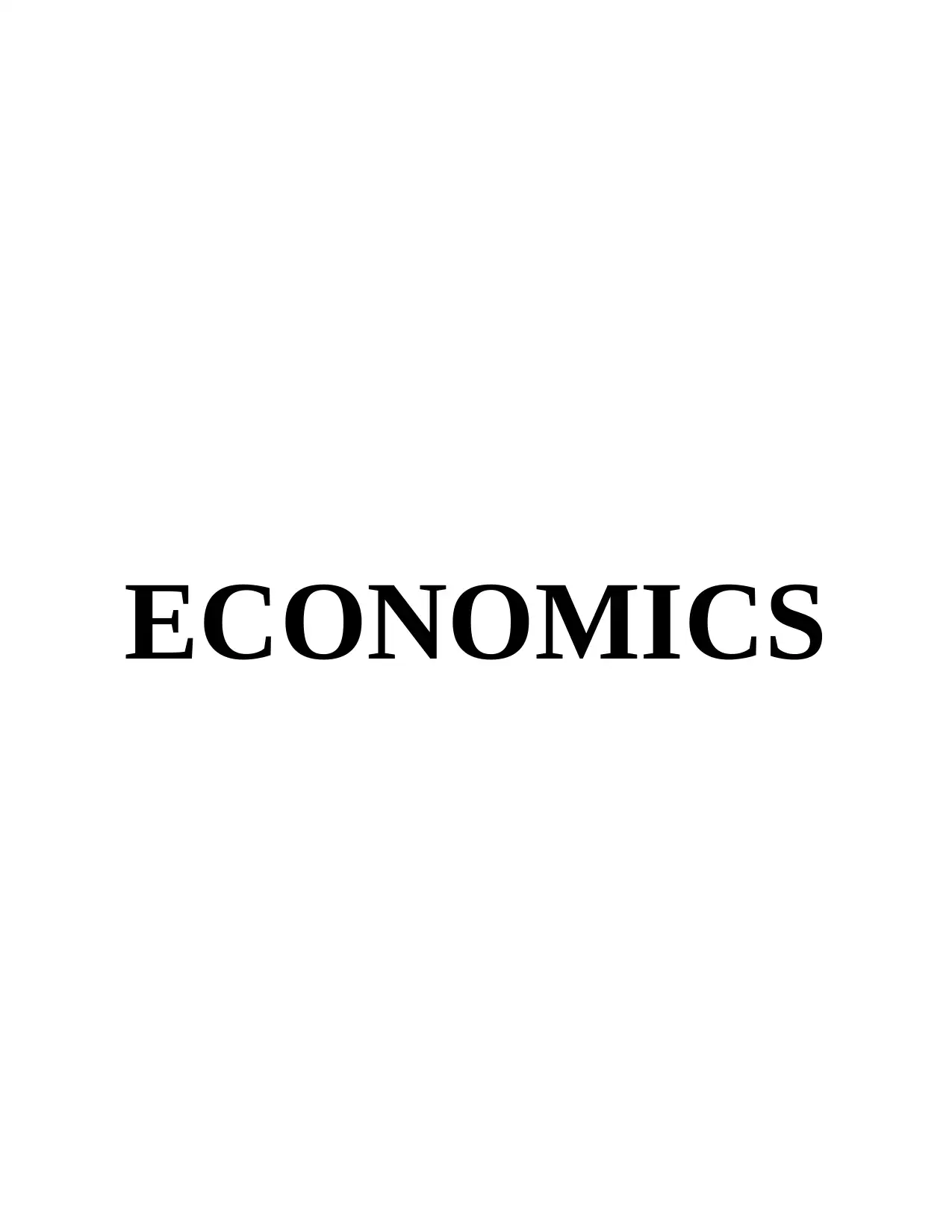
ECONOMICS
Paraphrase This Document
Need a fresh take? Get an instant paraphrase of this document with our AI Paraphraser
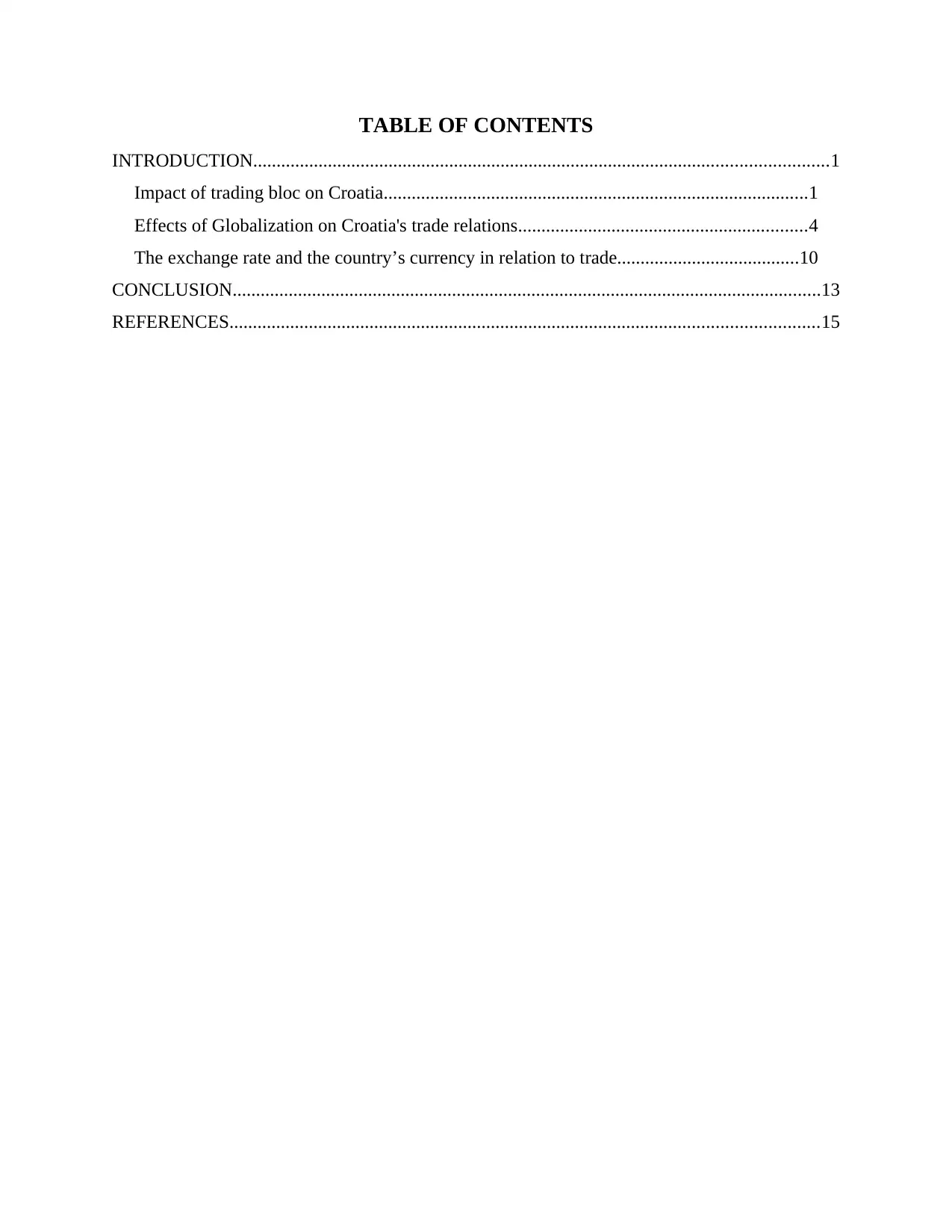
TABLE OF CONTENTS
INTRODUCTION...........................................................................................................................1
Impact of trading bloc on Croatia...........................................................................................1
Effects of Globalization on Croatia's trade relations..............................................................4
The exchange rate and the country’s currency in relation to trade.......................................10
CONCLUSION..............................................................................................................................13
REFERENCES..............................................................................................................................15
INTRODUCTION...........................................................................................................................1
Impact of trading bloc on Croatia...........................................................................................1
Effects of Globalization on Croatia's trade relations..............................................................4
The exchange rate and the country’s currency in relation to trade.......................................10
CONCLUSION..............................................................................................................................13
REFERENCES..............................................................................................................................15
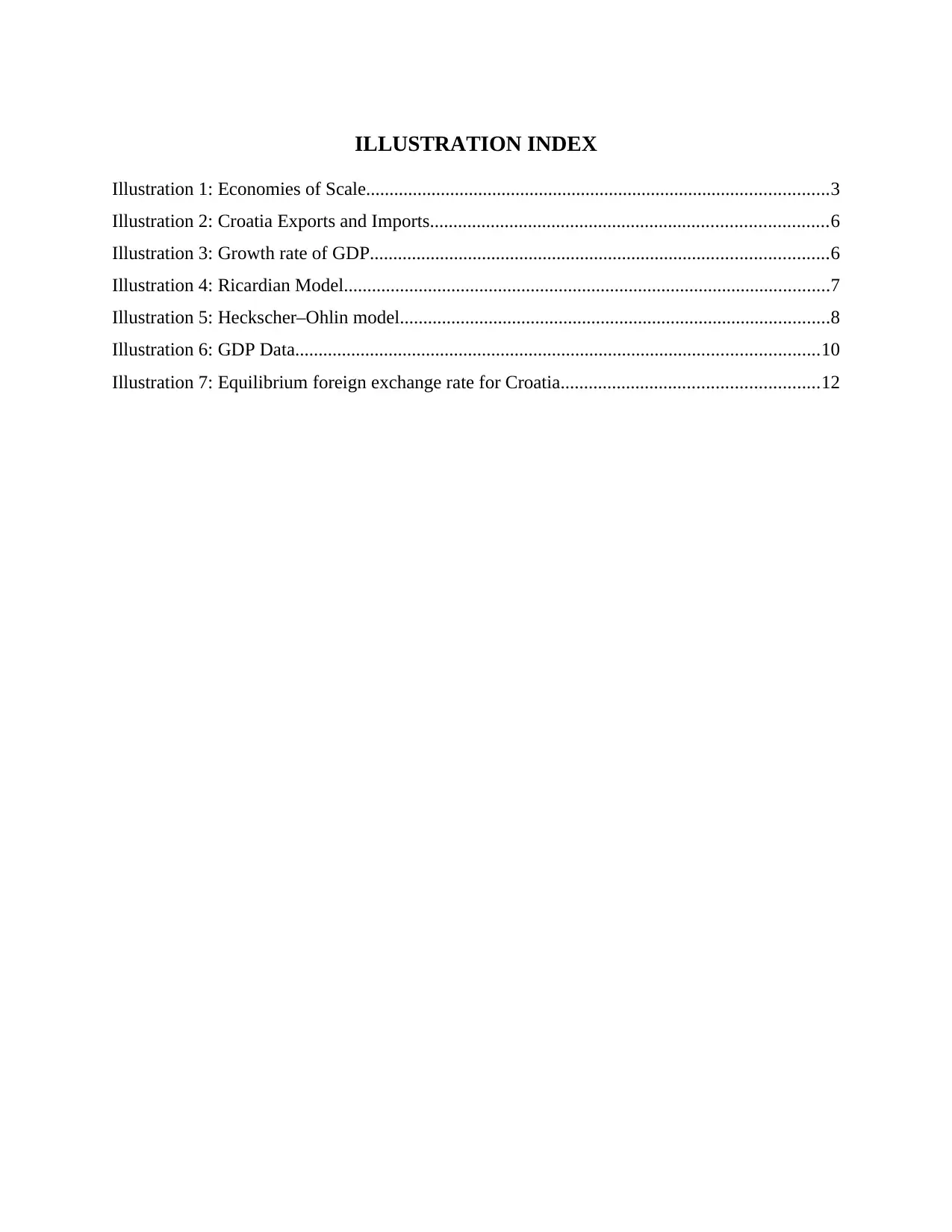
ILLUSTRATION INDEX
Illustration 1: Economies of Scale...................................................................................................3
Illustration 2: Croatia Exports and Imports.....................................................................................6
Illustration 3: Growth rate of GDP..................................................................................................6
Illustration 4: Ricardian Model........................................................................................................7
Illustration 5: Heckscher–Ohlin model............................................................................................8
Illustration 6: GDP Data................................................................................................................10
Illustration 7: Equilibrium foreign exchange rate for Croatia.......................................................12
Illustration 1: Economies of Scale...................................................................................................3
Illustration 2: Croatia Exports and Imports.....................................................................................6
Illustration 3: Growth rate of GDP..................................................................................................6
Illustration 4: Ricardian Model........................................................................................................7
Illustration 5: Heckscher–Ohlin model............................................................................................8
Illustration 6: GDP Data................................................................................................................10
Illustration 7: Equilibrium foreign exchange rate for Croatia.......................................................12
⊘ This is a preview!⊘
Do you want full access?
Subscribe today to unlock all pages.

Trusted by 1+ million students worldwide
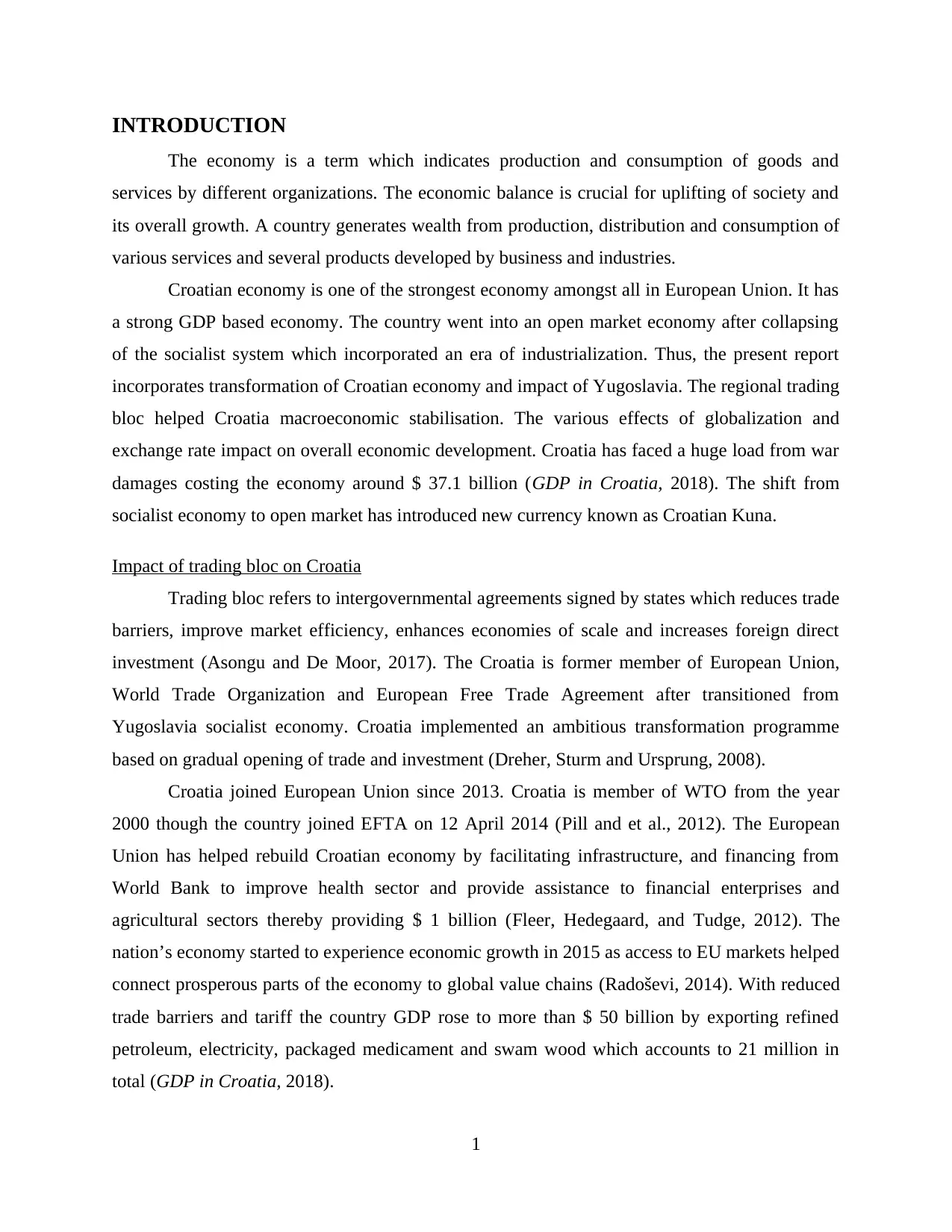
INTRODUCTION
The economy is a term which indicates production and consumption of goods and
services by different organizations. The economic balance is crucial for uplifting of society and
its overall growth. A country generates wealth from production, distribution and consumption of
various services and several products developed by business and industries.
Croatian economy is one of the strongest economy amongst all in European Union. It has
a strong GDP based economy. The country went into an open market economy after collapsing
of the socialist system which incorporated an era of industrialization. Thus, the present report
incorporates transformation of Croatian economy and impact of Yugoslavia. The regional trading
bloc helped Croatia macroeconomic stabilisation. The various effects of globalization and
exchange rate impact on overall economic development. Croatia has faced a huge load from war
damages costing the economy around $ 37.1 billion (GDP in Croatia, 2018). The shift from
socialist economy to open market has introduced new currency known as Croatian Kuna.
Impact of trading bloc on Croatia
Trading bloc refers to intergovernmental agreements signed by states which reduces trade
barriers, improve market efficiency, enhances economies of scale and increases foreign direct
investment (Asongu and De Moor, 2017). The Croatia is former member of European Union,
World Trade Organization and European Free Trade Agreement after transitioned from
Yugoslavia socialist economy. Croatia implemented an ambitious transformation programme
based on gradual opening of trade and investment (Dreher, Sturm and Ursprung, 2008).
Croatia joined European Union since 2013. Croatia is member of WTO from the year
2000 though the country joined EFTA on 12 April 2014 (Pill and et al., 2012). The European
Union has helped rebuild Croatian economy by facilitating infrastructure, and financing from
World Bank to improve health sector and provide assistance to financial enterprises and
agricultural sectors thereby providing $ 1 billion (Fleer, Hedegaard, and Tudge, 2012). The
nation’s economy started to experience economic growth in 2015 as access to EU markets helped
connect prosperous parts of the economy to global value chains (Radoševi, 2014). With reduced
trade barriers and tariff the country GDP rose to more than $ 50 billion by exporting refined
petroleum, electricity, packaged medicament and swam wood which accounts to 21 million in
total (GDP in Croatia, 2018).
1
The economy is a term which indicates production and consumption of goods and
services by different organizations. The economic balance is crucial for uplifting of society and
its overall growth. A country generates wealth from production, distribution and consumption of
various services and several products developed by business and industries.
Croatian economy is one of the strongest economy amongst all in European Union. It has
a strong GDP based economy. The country went into an open market economy after collapsing
of the socialist system which incorporated an era of industrialization. Thus, the present report
incorporates transformation of Croatian economy and impact of Yugoslavia. The regional trading
bloc helped Croatia macroeconomic stabilisation. The various effects of globalization and
exchange rate impact on overall economic development. Croatia has faced a huge load from war
damages costing the economy around $ 37.1 billion (GDP in Croatia, 2018). The shift from
socialist economy to open market has introduced new currency known as Croatian Kuna.
Impact of trading bloc on Croatia
Trading bloc refers to intergovernmental agreements signed by states which reduces trade
barriers, improve market efficiency, enhances economies of scale and increases foreign direct
investment (Asongu and De Moor, 2017). The Croatia is former member of European Union,
World Trade Organization and European Free Trade Agreement after transitioned from
Yugoslavia socialist economy. Croatia implemented an ambitious transformation programme
based on gradual opening of trade and investment (Dreher, Sturm and Ursprung, 2008).
Croatia joined European Union since 2013. Croatia is member of WTO from the year
2000 though the country joined EFTA on 12 April 2014 (Pill and et al., 2012). The European
Union has helped rebuild Croatian economy by facilitating infrastructure, and financing from
World Bank to improve health sector and provide assistance to financial enterprises and
agricultural sectors thereby providing $ 1 billion (Fleer, Hedegaard, and Tudge, 2012). The
nation’s economy started to experience economic growth in 2015 as access to EU markets helped
connect prosperous parts of the economy to global value chains (Radoševi, 2014). With reduced
trade barriers and tariff the country GDP rose to more than $ 50 billion by exporting refined
petroleum, electricity, packaged medicament and swam wood which accounts to 21 million in
total (GDP in Croatia, 2018).
1
Paraphrase This Document
Need a fresh take? Get an instant paraphrase of this document with our AI Paraphraser
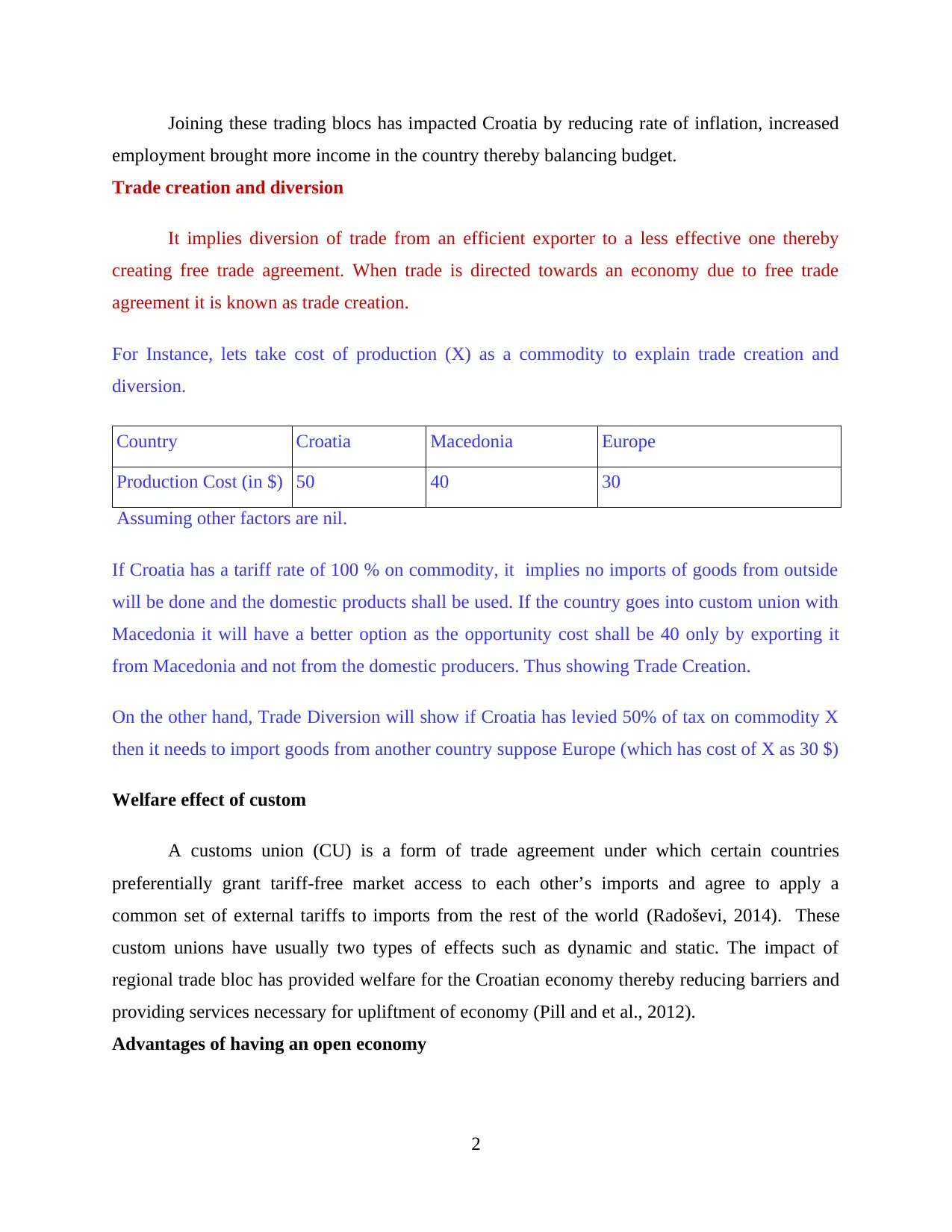
Joining these trading blocs has impacted Croatia by reducing rate of inflation, increased
employment brought more income in the country thereby balancing budget.
Trade creation and diversion
It implies diversion of trade from an efficient exporter to a less effective one thereby
creating free trade agreement. When trade is directed towards an economy due to free trade
agreement it is known as trade creation.
For Instance, lets take cost of production (X) as a commodity to explain trade creation and
diversion.
Country Croatia Macedonia Europe
Production Cost (in $) 50 40 30
Assuming other factors are nil.
If Croatia has a tariff rate of 100 % on commodity, it implies no imports of goods from outside
will be done and the domestic products shall be used. If the country goes into custom union with
Macedonia it will have a better option as the opportunity cost shall be 40 only by exporting it
from Macedonia and not from the domestic producers. Thus showing Trade Creation.
On the other hand, Trade Diversion will show if Croatia has levied 50% of tax on commodity X
then it needs to import goods from another country suppose Europe (which has cost of X as 30 $)
Welfare effect of custom
A customs union (CU) is a form of trade agreement under which certain countries
preferentially grant tariff-free market access to each other’s imports and agree to apply a
common set of external tariffs to imports from the rest of the world (Radoševi, 2014). These
custom unions have usually two types of effects such as dynamic and static. The impact of
regional trade bloc has provided welfare for the Croatian economy thereby reducing barriers and
providing services necessary for upliftment of economy (Pill and et al., 2012).
Advantages of having an open economy
2
employment brought more income in the country thereby balancing budget.
Trade creation and diversion
It implies diversion of trade from an efficient exporter to a less effective one thereby
creating free trade agreement. When trade is directed towards an economy due to free trade
agreement it is known as trade creation.
For Instance, lets take cost of production (X) as a commodity to explain trade creation and
diversion.
Country Croatia Macedonia Europe
Production Cost (in $) 50 40 30
Assuming other factors are nil.
If Croatia has a tariff rate of 100 % on commodity, it implies no imports of goods from outside
will be done and the domestic products shall be used. If the country goes into custom union with
Macedonia it will have a better option as the opportunity cost shall be 40 only by exporting it
from Macedonia and not from the domestic producers. Thus showing Trade Creation.
On the other hand, Trade Diversion will show if Croatia has levied 50% of tax on commodity X
then it needs to import goods from another country suppose Europe (which has cost of X as 30 $)
Welfare effect of custom
A customs union (CU) is a form of trade agreement under which certain countries
preferentially grant tariff-free market access to each other’s imports and agree to apply a
common set of external tariffs to imports from the rest of the world (Radoševi, 2014). These
custom unions have usually two types of effects such as dynamic and static. The impact of
regional trade bloc has provided welfare for the Croatian economy thereby reducing barriers and
providing services necessary for upliftment of economy (Pill and et al., 2012).
Advantages of having an open economy
2
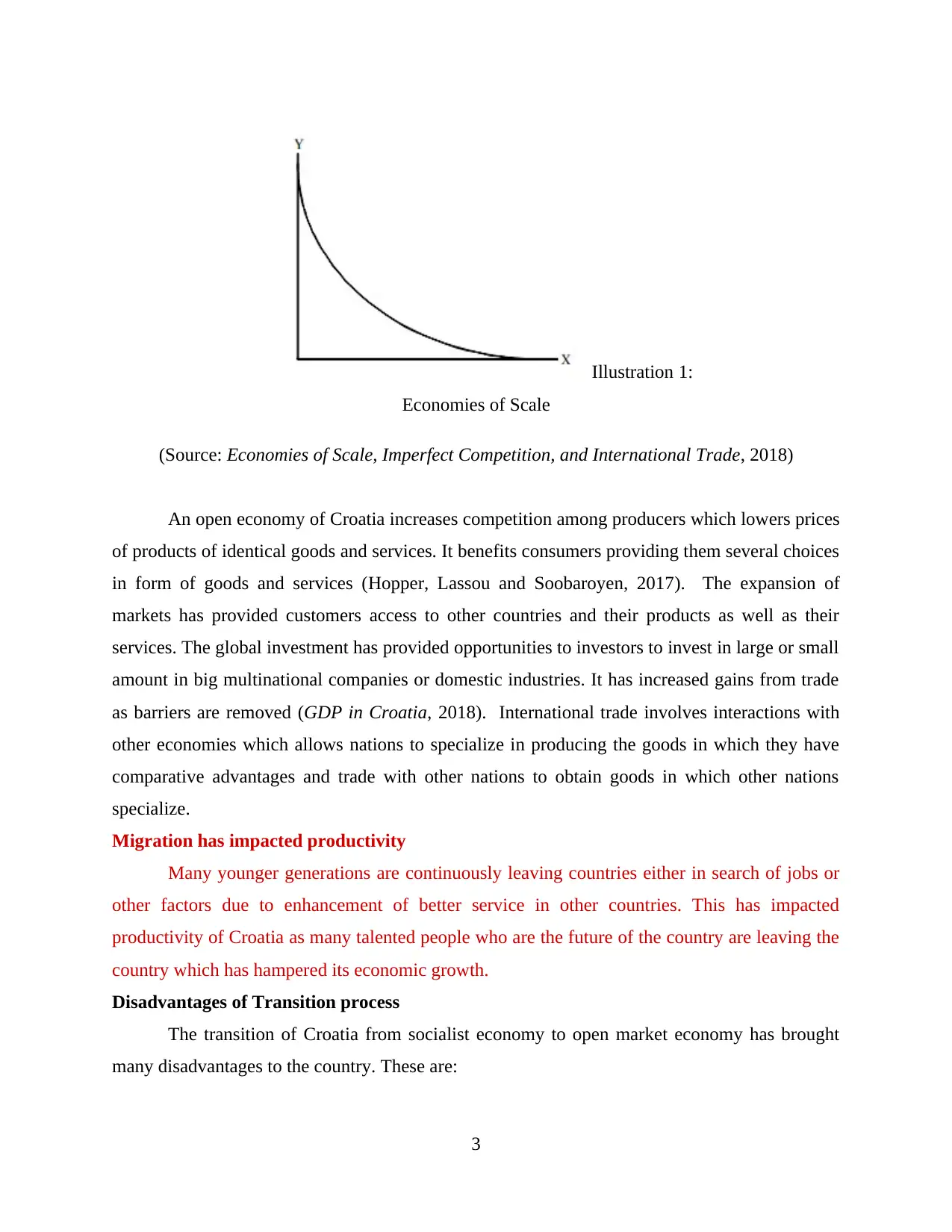
(Source: Economies of Scale, Imperfect Competition, and International Trade, 2018)
An open economy of Croatia increases competition among producers which lowers prices
of products of identical goods and services. It benefits consumers providing them several choices
in form of goods and services (Hopper, Lassou and Soobaroyen, 2017). The expansion of
markets has provided customers access to other countries and their products as well as their
services. The global investment has provided opportunities to investors to invest in large or small
amount in big multinational companies or domestic industries. It has increased gains from trade
as barriers are removed (GDP in Croatia, 2018). International trade involves interactions with
other economies which allows nations to specialize in producing the goods in which they have
comparative advantages and trade with other nations to obtain goods in which other nations
specialize.
Migration has impacted productivity
Many younger generations are continuously leaving countries either in search of jobs or
other factors due to enhancement of better service in other countries. This has impacted
productivity of Croatia as many talented people who are the future of the country are leaving the
country which has hampered its economic growth.
Disadvantages of Transition process
The transition of Croatia from socialist economy to open market economy has brought
many disadvantages to the country. These are:
3
Illustration 1:
Economies of Scale
An open economy of Croatia increases competition among producers which lowers prices
of products of identical goods and services. It benefits consumers providing them several choices
in form of goods and services (Hopper, Lassou and Soobaroyen, 2017). The expansion of
markets has provided customers access to other countries and their products as well as their
services. The global investment has provided opportunities to investors to invest in large or small
amount in big multinational companies or domestic industries. It has increased gains from trade
as barriers are removed (GDP in Croatia, 2018). International trade involves interactions with
other economies which allows nations to specialize in producing the goods in which they have
comparative advantages and trade with other nations to obtain goods in which other nations
specialize.
Migration has impacted productivity
Many younger generations are continuously leaving countries either in search of jobs or
other factors due to enhancement of better service in other countries. This has impacted
productivity of Croatia as many talented people who are the future of the country are leaving the
country which has hampered its economic growth.
Disadvantages of Transition process
The transition of Croatia from socialist economy to open market economy has brought
many disadvantages to the country. These are:
3
Illustration 1:
Economies of Scale
⊘ This is a preview!⊘
Do you want full access?
Subscribe today to unlock all pages.

Trusted by 1+ million students worldwide
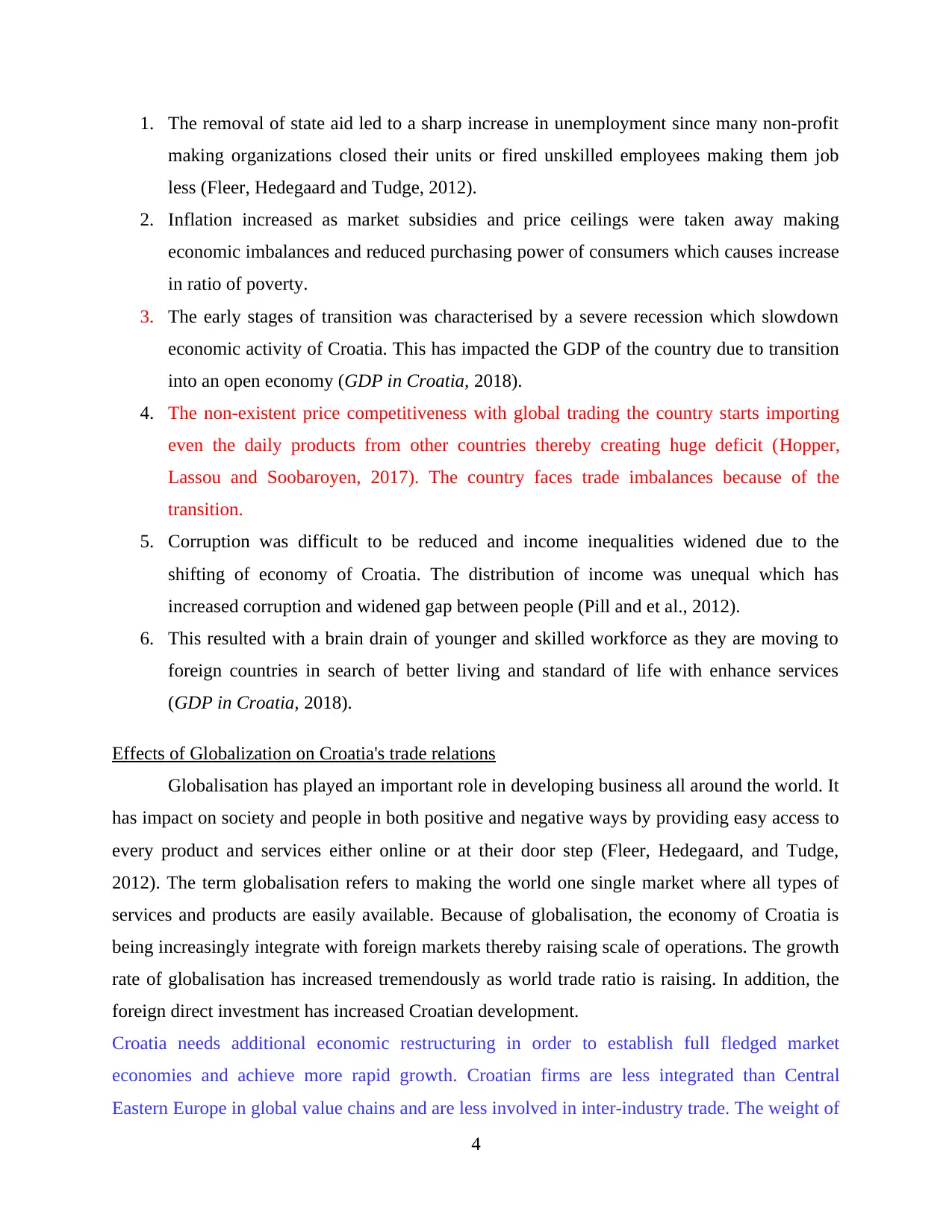
1. The removal of state aid led to a sharp increase in unemployment since many non-profit
making organizations closed their units or fired unskilled employees making them job
less (Fleer, Hedegaard and Tudge, 2012).
2. Inflation increased as market subsidies and price ceilings were taken away making
economic imbalances and reduced purchasing power of consumers which causes increase
in ratio of poverty.
3. The early stages of transition was characterised by a severe recession which slowdown
economic activity of Croatia. This has impacted the GDP of the country due to transition
into an open economy (GDP in Croatia, 2018).
4. The non-existent price competitiveness with global trading the country starts importing
even the daily products from other countries thereby creating huge deficit (Hopper,
Lassou and Soobaroyen, 2017). The country faces trade imbalances because of the
transition.
5. Corruption was difficult to be reduced and income inequalities widened due to the
shifting of economy of Croatia. The distribution of income was unequal which has
increased corruption and widened gap between people (Pill and et al., 2012).
6. This resulted with a brain drain of younger and skilled workforce as they are moving to
foreign countries in search of better living and standard of life with enhance services
(GDP in Croatia, 2018).
Effects of Globalization on Croatia's trade relations
Globalisation has played an important role in developing business all around the world. It
has impact on society and people in both positive and negative ways by providing easy access to
every product and services either online or at their door step (Fleer, Hedegaard, and Tudge,
2012). The term globalisation refers to making the world one single market where all types of
services and products are easily available. Because of globalisation, the economy of Croatia is
being increasingly integrate with foreign markets thereby raising scale of operations. The growth
rate of globalisation has increased tremendously as world trade ratio is raising. In addition, the
foreign direct investment has increased Croatian development.
Croatia needs additional economic restructuring in order to establish full fledged market
economies and achieve more rapid growth. Croatian firms are less integrated than Central
Eastern Europe in global value chains and are less involved in inter-industry trade. The weight of
4
making organizations closed their units or fired unskilled employees making them job
less (Fleer, Hedegaard and Tudge, 2012).
2. Inflation increased as market subsidies and price ceilings were taken away making
economic imbalances and reduced purchasing power of consumers which causes increase
in ratio of poverty.
3. The early stages of transition was characterised by a severe recession which slowdown
economic activity of Croatia. This has impacted the GDP of the country due to transition
into an open economy (GDP in Croatia, 2018).
4. The non-existent price competitiveness with global trading the country starts importing
even the daily products from other countries thereby creating huge deficit (Hopper,
Lassou and Soobaroyen, 2017). The country faces trade imbalances because of the
transition.
5. Corruption was difficult to be reduced and income inequalities widened due to the
shifting of economy of Croatia. The distribution of income was unequal which has
increased corruption and widened gap between people (Pill and et al., 2012).
6. This resulted with a brain drain of younger and skilled workforce as they are moving to
foreign countries in search of better living and standard of life with enhance services
(GDP in Croatia, 2018).
Effects of Globalization on Croatia's trade relations
Globalisation has played an important role in developing business all around the world. It
has impact on society and people in both positive and negative ways by providing easy access to
every product and services either online or at their door step (Fleer, Hedegaard, and Tudge,
2012). The term globalisation refers to making the world one single market where all types of
services and products are easily available. Because of globalisation, the economy of Croatia is
being increasingly integrate with foreign markets thereby raising scale of operations. The growth
rate of globalisation has increased tremendously as world trade ratio is raising. In addition, the
foreign direct investment has increased Croatian development.
Croatia needs additional economic restructuring in order to establish full fledged market
economies and achieve more rapid growth. Croatian firms are less integrated than Central
Eastern Europe in global value chains and are less involved in inter-industry trade. The weight of
4
Paraphrase This Document
Need a fresh take? Get an instant paraphrase of this document with our AI Paraphraser
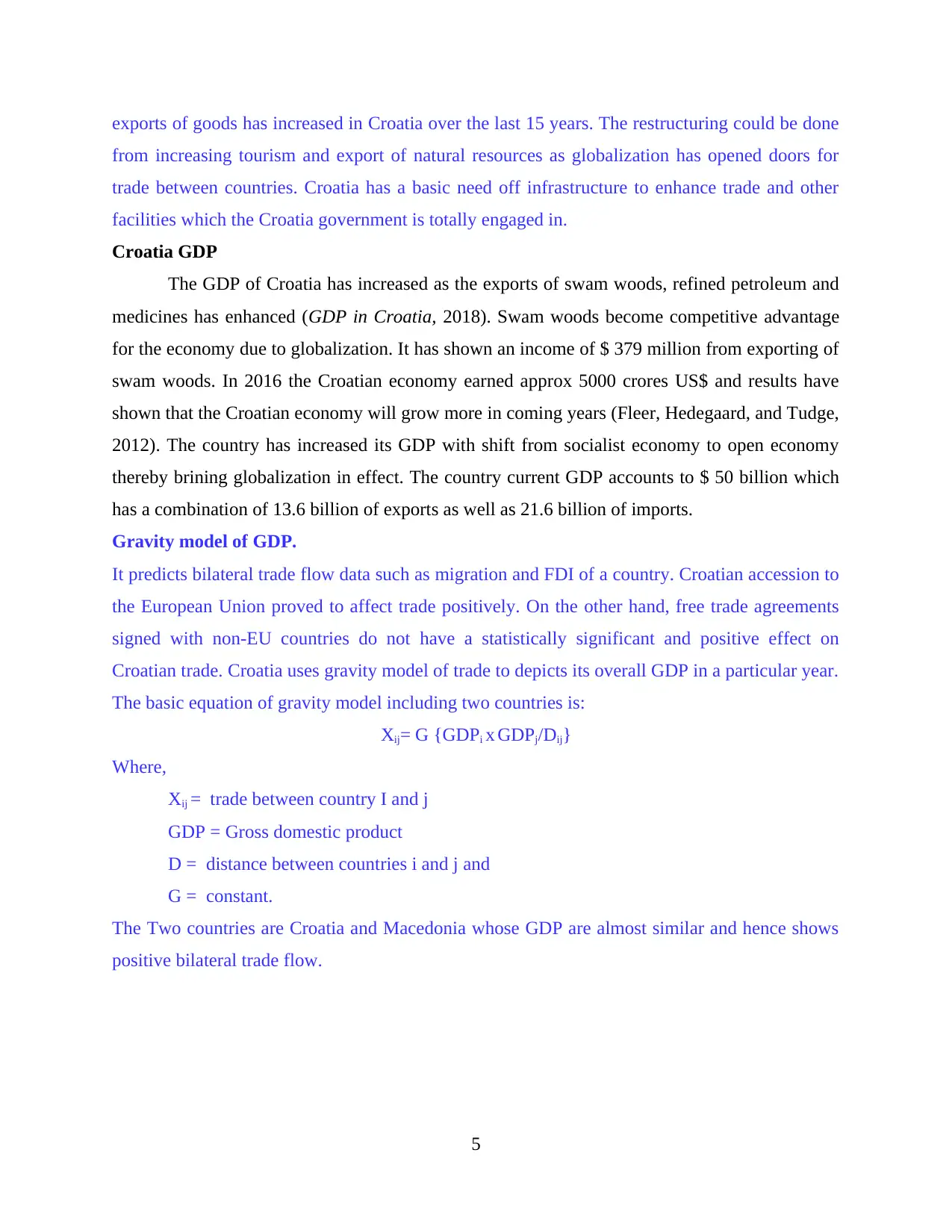
exports of goods has increased in Croatia over the last 15 years. The restructuring could be done
from increasing tourism and export of natural resources as globalization has opened doors for
trade between countries. Croatia has a basic need off infrastructure to enhance trade and other
facilities which the Croatia government is totally engaged in.
Croatia GDP
The GDP of Croatia has increased as the exports of swam woods, refined petroleum and
medicines has enhanced (GDP in Croatia, 2018). Swam woods become competitive advantage
for the economy due to globalization. It has shown an income of $ 379 million from exporting of
swam woods. In 2016 the Croatian economy earned approx 5000 crores US$ and results have
shown that the Croatian economy will grow more in coming years (Fleer, Hedegaard, and Tudge,
2012). The country has increased its GDP with shift from socialist economy to open economy
thereby brining globalization in effect. The country current GDP accounts to $ 50 billion which
has a combination of 13.6 billion of exports as well as 21.6 billion of imports.
Gravity model of GDP.
It predicts bilateral trade flow data such as migration and FDI of a country. Croatian accession to
the European Union proved to affect trade positively. On the other hand, free trade agreements
signed with non-EU countries do not have a statistically significant and positive effect on
Croatian trade. Croatia uses gravity model of trade to depicts its overall GDP in a particular year.
The basic equation of gravity model including two countries is:
Xij= G {GDPi x GDPj/Dij}
Where,
Xij = trade between country I and j
GDP = Gross domestic product
D = distance between countries i and j and
G = constant.
The Two countries are Croatia and Macedonia whose GDP are almost similar and hence shows
positive bilateral trade flow.
5
from increasing tourism and export of natural resources as globalization has opened doors for
trade between countries. Croatia has a basic need off infrastructure to enhance trade and other
facilities which the Croatia government is totally engaged in.
Croatia GDP
The GDP of Croatia has increased as the exports of swam woods, refined petroleum and
medicines has enhanced (GDP in Croatia, 2018). Swam woods become competitive advantage
for the economy due to globalization. It has shown an income of $ 379 million from exporting of
swam woods. In 2016 the Croatian economy earned approx 5000 crores US$ and results have
shown that the Croatian economy will grow more in coming years (Fleer, Hedegaard, and Tudge,
2012). The country has increased its GDP with shift from socialist economy to open economy
thereby brining globalization in effect. The country current GDP accounts to $ 50 billion which
has a combination of 13.6 billion of exports as well as 21.6 billion of imports.
Gravity model of GDP.
It predicts bilateral trade flow data such as migration and FDI of a country. Croatian accession to
the European Union proved to affect trade positively. On the other hand, free trade agreements
signed with non-EU countries do not have a statistically significant and positive effect on
Croatian trade. Croatia uses gravity model of trade to depicts its overall GDP in a particular year.
The basic equation of gravity model including two countries is:
Xij= G {GDPi x GDPj/Dij}
Where,
Xij = trade between country I and j
GDP = Gross domestic product
D = distance between countries i and j and
G = constant.
The Two countries are Croatia and Macedonia whose GDP are almost similar and hence shows
positive bilateral trade flow.
5
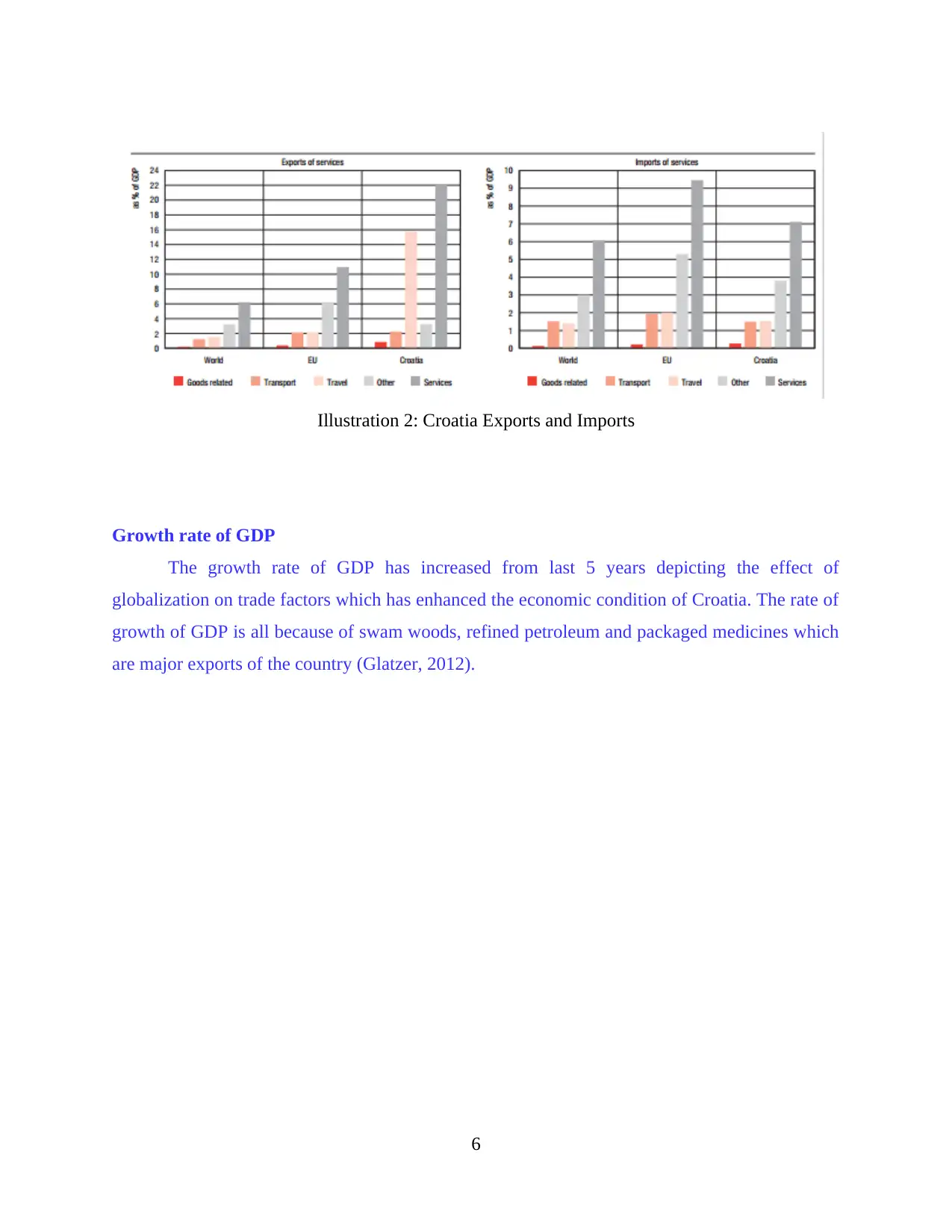
Growth rate of GDP
The growth rate of GDP has increased from last 5 years depicting the effect of
globalization on trade factors which has enhanced the economic condition of Croatia. The rate of
growth of GDP is all because of swam woods, refined petroleum and packaged medicines which
are major exports of the country (Glatzer, 2012).
6
Illustration 2: Croatia Exports and Imports
The growth rate of GDP has increased from last 5 years depicting the effect of
globalization on trade factors which has enhanced the economic condition of Croatia. The rate of
growth of GDP is all because of swam woods, refined petroleum and packaged medicines which
are major exports of the country (Glatzer, 2012).
6
Illustration 2: Croatia Exports and Imports
⊘ This is a preview!⊘
Do you want full access?
Subscribe today to unlock all pages.

Trusted by 1+ million students worldwide
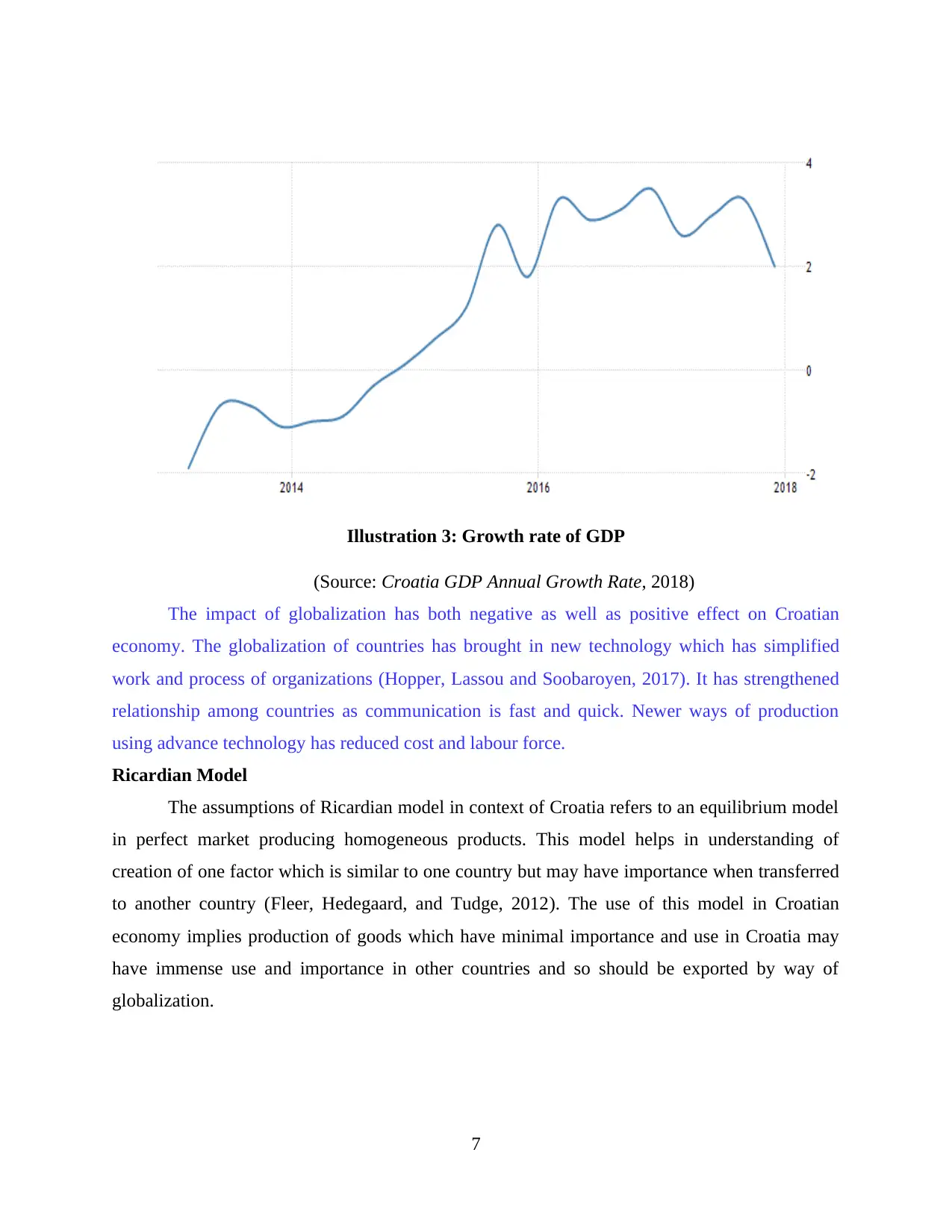
(Source: Croatia GDP Annual Growth Rate, 2018)
The impact of globalization has both negative as well as positive effect on Croatian
economy. The globalization of countries has brought in new technology which has simplified
work and process of organizations (Hopper, Lassou and Soobaroyen, 2017). It has strengthened
relationship among countries as communication is fast and quick. Newer ways of production
using advance technology has reduced cost and labour force.
Ricardian Model
The assumptions of Ricardian model in context of Croatia refers to an equilibrium model
in perfect market producing homogeneous products. This model helps in understanding of
creation of one factor which is similar to one country but may have importance when transferred
to another country (Fleer, Hedegaard, and Tudge, 2012). The use of this model in Croatian
economy implies production of goods which have minimal importance and use in Croatia may
have immense use and importance in other countries and so should be exported by way of
globalization.
7
Illustration 3: Growth rate of GDP
The impact of globalization has both negative as well as positive effect on Croatian
economy. The globalization of countries has brought in new technology which has simplified
work and process of organizations (Hopper, Lassou and Soobaroyen, 2017). It has strengthened
relationship among countries as communication is fast and quick. Newer ways of production
using advance technology has reduced cost and labour force.
Ricardian Model
The assumptions of Ricardian model in context of Croatia refers to an equilibrium model
in perfect market producing homogeneous products. This model helps in understanding of
creation of one factor which is similar to one country but may have importance when transferred
to another country (Fleer, Hedegaard, and Tudge, 2012). The use of this model in Croatian
economy implies production of goods which have minimal importance and use in Croatia may
have immense use and importance in other countries and so should be exported by way of
globalization.
7
Illustration 3: Growth rate of GDP
Paraphrase This Document
Need a fresh take? Get an instant paraphrase of this document with our AI Paraphraser
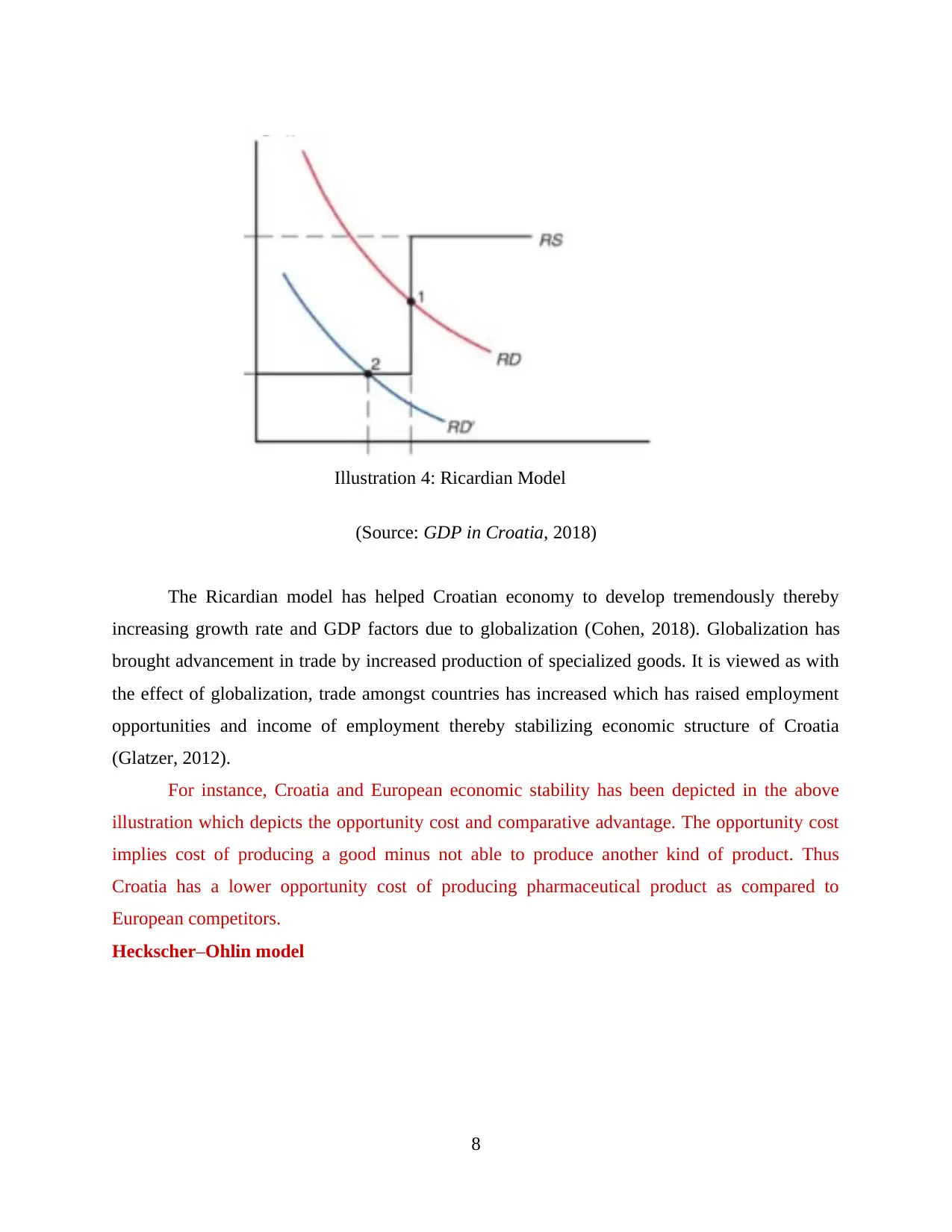
(Source: GDP in Croatia, 2018)
The Ricardian model has helped Croatian economy to develop tremendously thereby
increasing growth rate and GDP factors due to globalization (Cohen, 2018). Globalization has
brought advancement in trade by increased production of specialized goods. It is viewed as with
the effect of globalization, trade amongst countries has increased which has raised employment
opportunities and income of employment thereby stabilizing economic structure of Croatia
(Glatzer, 2012).
For instance, Croatia and European economic stability has been depicted in the above
illustration which depicts the opportunity cost and comparative advantage. The opportunity cost
implies cost of producing a good minus not able to produce another kind of product. Thus
Croatia has a lower opportunity cost of producing pharmaceutical product as compared to
European competitors.
Heckscher–Ohlin model
8
Illustration 4: Ricardian Model
The Ricardian model has helped Croatian economy to develop tremendously thereby
increasing growth rate and GDP factors due to globalization (Cohen, 2018). Globalization has
brought advancement in trade by increased production of specialized goods. It is viewed as with
the effect of globalization, trade amongst countries has increased which has raised employment
opportunities and income of employment thereby stabilizing economic structure of Croatia
(Glatzer, 2012).
For instance, Croatia and European economic stability has been depicted in the above
illustration which depicts the opportunity cost and comparative advantage. The opportunity cost
implies cost of producing a good minus not able to produce another kind of product. Thus
Croatia has a lower opportunity cost of producing pharmaceutical product as compared to
European competitors.
Heckscher–Ohlin model
8
Illustration 4: Ricardian Model
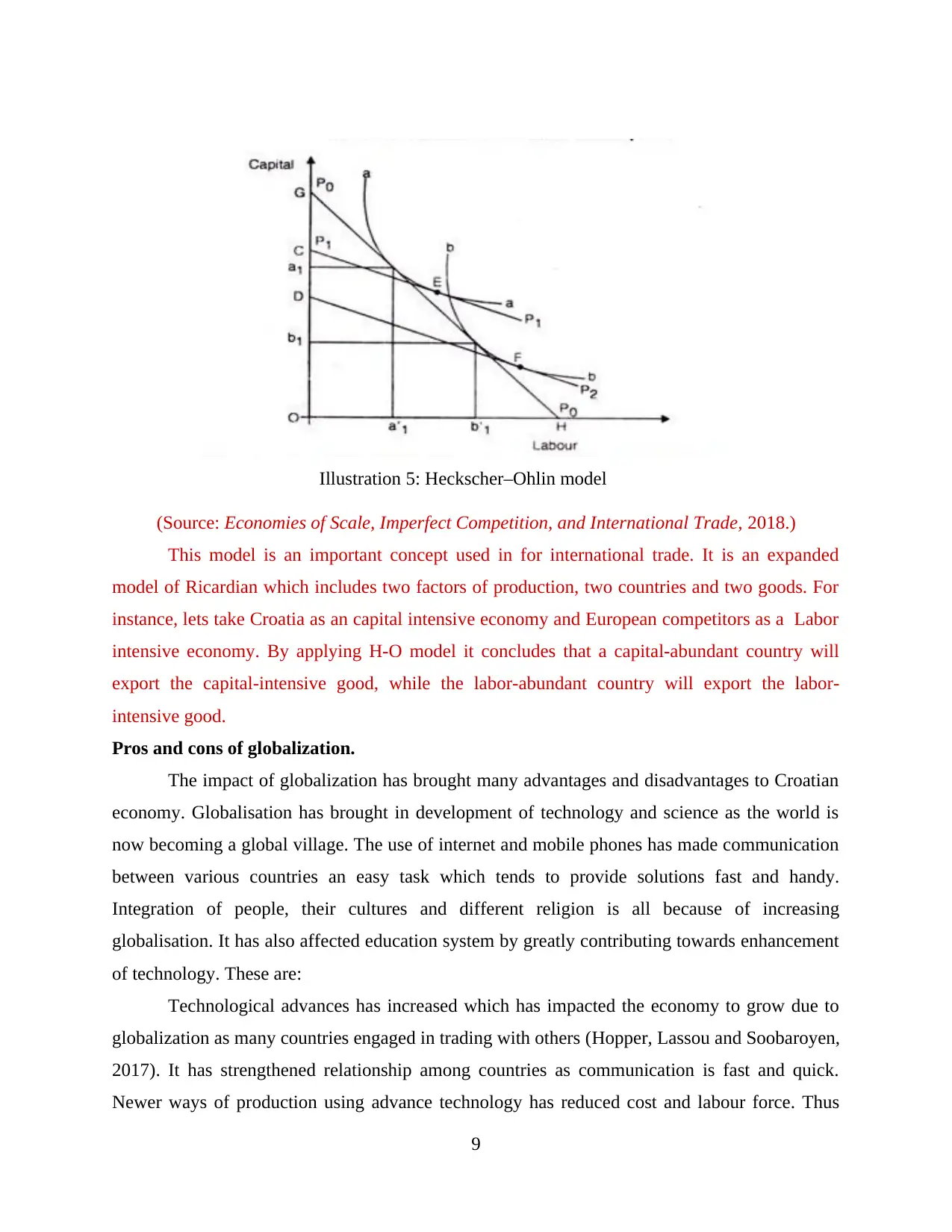
(Source: Economies of Scale, Imperfect Competition, and International Trade, 2018.)
This model is an important concept used in for international trade. It is an expanded
model of Ricardian which includes two factors of production, two countries and two goods. For
instance, lets take Croatia as an capital intensive economy and European competitors as a Labor
intensive economy. By applying H-O model it concludes that a capital-abundant country will
export the capital-intensive good, while the labor-abundant country will export the labor-
intensive good.
Pros and cons of globalization.
The impact of globalization has brought many advantages and disadvantages to Croatian
economy. Globalisation has brought in development of technology and science as the world is
now becoming a global village. The use of internet and mobile phones has made communication
between various countries an easy task which tends to provide solutions fast and handy.
Integration of people, their cultures and different religion is all because of increasing
globalisation. It has also affected education system by greatly contributing towards enhancement
of technology. These are:
Technological advances has increased which has impacted the economy to grow due to
globalization as many countries engaged in trading with others (Hopper, Lassou and Soobaroyen,
2017). It has strengthened relationship among countries as communication is fast and quick.
Newer ways of production using advance technology has reduced cost and labour force. Thus
9
Illustration 5: Heckscher–Ohlin model
This model is an important concept used in for international trade. It is an expanded
model of Ricardian which includes two factors of production, two countries and two goods. For
instance, lets take Croatia as an capital intensive economy and European competitors as a Labor
intensive economy. By applying H-O model it concludes that a capital-abundant country will
export the capital-intensive good, while the labor-abundant country will export the labor-
intensive good.
Pros and cons of globalization.
The impact of globalization has brought many advantages and disadvantages to Croatian
economy. Globalisation has brought in development of technology and science as the world is
now becoming a global village. The use of internet and mobile phones has made communication
between various countries an easy task which tends to provide solutions fast and handy.
Integration of people, their cultures and different religion is all because of increasing
globalisation. It has also affected education system by greatly contributing towards enhancement
of technology. These are:
Technological advances has increased which has impacted the economy to grow due to
globalization as many countries engaged in trading with others (Hopper, Lassou and Soobaroyen,
2017). It has strengthened relationship among countries as communication is fast and quick.
Newer ways of production using advance technology has reduced cost and labour force. Thus
9
Illustration 5: Heckscher–Ohlin model
⊘ This is a preview!⊘
Do you want full access?
Subscribe today to unlock all pages.

Trusted by 1+ million students worldwide
1 out of 19
Related Documents
Your All-in-One AI-Powered Toolkit for Academic Success.
+13062052269
info@desklib.com
Available 24*7 on WhatsApp / Email
![[object Object]](/_next/static/media/star-bottom.7253800d.svg)
Unlock your academic potential
Copyright © 2020–2025 A2Z Services. All Rights Reserved. Developed and managed by ZUCOL.





